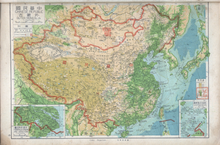Chinese Post's transcription system
The Chinese Post's transcription system ( Chinese 郵政 式 拼音 / 邮政 式 拼音 , Pinyin Yóuzhèngshì Pīnyīn , W.-G. Yu 2 -cheng 4 -shih 4 P'in 1 -yin 1 ) was the transcription system for Chinese place names that was used in the came into use in the late Qing Dynasty and was officially sanctioned by the Imperial Joint Postal Conference ( 帝國 郵電 聯席會議 / 帝国 邮电 联席会议 , Dìguó Yóudiàn Liánxí Huìyì ) held in Shanghai in the spring of 1906. This transcription system was retained after the fall of the Qing Dynasty (1912), and since it has since been used in the official postal atlas of the Republic of China , it remained the usual way of translating Chinese place names in the west by cartographers until well into the 20th century .
After the founding of the People's Republic of China , the replacement of the Republic of China by it at the United Nations in 1972 and the use of pinyin as the international standard by the ISO in 1982 , the Chinese Post's transcription system was partially replaced by pinyin for Han Chinese place names and SASM / GNC transcription for place names of ethnic minority languages, which is now accepted almost worldwide.
The system built on Wade-Giles for use in the postal service, especially place names in the official postal atlas, letters and postage stamps. It uses some of the then common European names for Chinese places that took precedence over the Wade-Giles spelling, and includes some dialectal and historical pronunciations.
The main differences from Wade-Giles include: a .:
- Complete absence of diacritical and accent marks (accents / tone marks).
- Chi , ch'i , and hsi (Pinyin ji , qi , and xi ) are represented either by tsi , tsi and si or by ki , ki and hi , depending on the historical pronunciation, for example:
- the Wade-Giles u becomes w unless it is the only vowel, for example:
- Place names from the Guangdong , Guangxi and Fujian areas are transcribed from the local dialects, e.g. B. Hokkien , Teochew , Cantonese (transcription systems also taken from Giles' A Chinese-English Dictionary ).
- Widespread pre-existing (19th century or earlier) European names for places in China are retained, such as the names of the treaty ports , e.g. B .:
- Canton (Kuang-chou, Guangzhou)
Other orthographic features include:
- hs- becomes sh- or -s , for example Kishien (from Chi-hsien , Jixian)
- -ê ( schwa ) and -ei both become -eh , for example Chengteh (from Ch'eng-te , Chengde) and Pehkiao (from Pei-ch'iao , Beiqiao). -ê can sometimes be -e or -ei .
- Final u sometimes becomes -uh , e.g. Wensuh (from Wen-su , Wensu)
See also
- Postal History and Postage Stamps of China
- Postal history and stamps of the treaty ports
- List of transcription systems for the Chinese languages
literature
- China postal album: showing the postal establishments and postal routes in each province. 2nd Edition. Directorate General of Posts, Beijing 1919.
- China postal album: showing the postal establishments and postal routes in each province. 3. Edition. Directorate General of Posts, Nanking 1936.
- GMH Playfair: The Cities and Towns of China: A Geographical Dictionary. 2nd Edition. Kelly & Walsh, Shanghai 1910.
- Lane Harris, A 'Lasting Boon to All': A Note on the Postal Romanization of Place Names, 1896-1949. In: Twentieth Century China. 34, no. 1, 2008, pp. 96-109. (muse.jhu.edu) .
- Yóuzhèng shì pīnyīn. (邮政 式 拼音) Zhōngguó dà bǎikē quánshū: Yuyán wénzì (中国 大 百科全书 : 语言 文字). Zhōngguó dà bǎikē quánshū chūbǎnshè (中国 大 百科全书 出版社), Beijing 1998.
Individual evidence
- ^ Pinyin - ISO 7098: 1991 - Documentation - Romanization of Chinese . Retrieved March 1, 2009.

